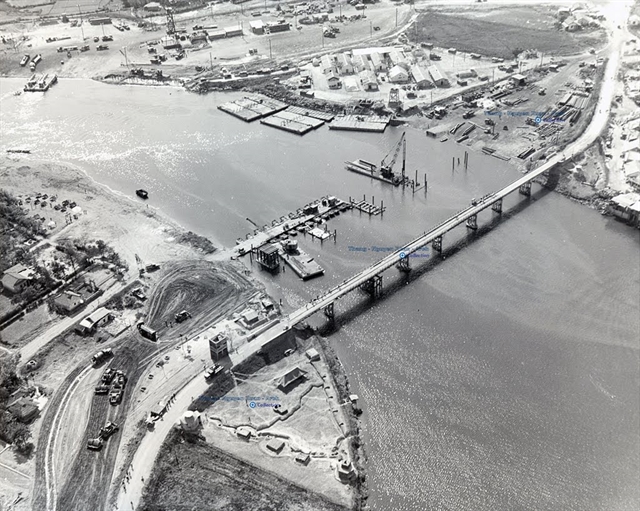 In the Spotlight
In the Spotlight

A tunnel break in the Sông Bung 2 hydroelectric power plant in the central province of Quảng Nam released nearly 30 million cubic metres of water that rushed to thousands of villagers living downstream, klling two, and caused at least VNĐ5 billion of losses. The latest incident raised alarms about whether the hydropower plants in Việt Nam meet safety requirements, especially when the Sông Bung 2 had already passed the highest examination bars
 |
A tunnel break in the Sông Bung 2 hydroelectric power plant in the central province of Quảng Nam released nearly 30 million cubic metres of water that rushed to thousands of villagers living downstream, klling two, and caused at least VNĐ5 billion of losses. The latest incident raised alarms about whether the hydropower plants in Việt Nam meet safety requirements, especially when the Sông Bung 2 had already passed the highest examination bars
HÀ NỘI — The Sông Bung 2 hydropower incident washed away two people, one of who is still missing, and local residents cannot shake off the horrifying thought that they, too, might have been among the dead.
At about 4pm on September 13, a tunnel temporarily used to divert water away from the dam of the under-construction Sông Bung 2 hydropower plant in the central province of Quảng Nam, suddenly burst. At least 28 million cubic metres of water stored for about 10 days rushed out of the tunnel like a colossal water cannon sweeping away village homes downstream.
Thousands of villagers living in the four communes located by the Bung River vividly remember the striking thunderstorm-like sound followed minutes later by the unexpected flooding.
Villagers in Cha Val Commune spent the night trying to contact more than 60 people working deep in a nearby forest, which was also under water.
They described it as being like “during wartime” when women and children kept crying and screaming in the middle of the night while men went to look for the missing in the forest.
Fortunately, all of those 60 and many others reported missing that night in other villages managed to survive and returned home the next morning - only to find that their houses, animals and farming fields had been washed away.
Nam Giang District People’s Committee estimated the damages caused by the incident at VNĐ5 billion (US$222,000), with about 1.2ha of fishing ponds, 9ha of agriculture fields and a dozen houses destroyed. The water was also so strong that it washed away a 25-tonne crane, two excavators and five trucks from the power plant construction site.
Việt Nam Irrigation Association Chairman Vũ Trọng Hồng told Việt Nam News that though the incident was disastrous, it was still lucky that the dam only stored 28 million cubic metres at the time.
“If it had reached its full water capacity (100 cubic metres), the Sông Bung 4 plant’s dam located lower would have surely broken,” he said.
Sông Bung 2 is among five hydropower plants built along the Bung River.
As the Ministry of Industry and Trade (MoIT), the state agency in charge of hydropower plants, set up an investigation team which will directly report to the Prime Minister, Quảng Nam authorities and the Sông Bung 2’s investor were still busy firing accusations at each other over who was to blame for the incident.
Regardless of those responsible for the disaster, the incident serves as a warning about the quality of hydropower plants in Việt Nam, Hồng said.
“Sông Bung 2 already reached the stage of storing water, which means that it was already checked by the MoIT. There were no higher levels for examination,” he said. “And yet it still broke.”
It might not be mere coincidence that the investor of the Sông Bung 2 - EVNGENCO 2, a subsidiary of the state-owned Electricity Vietnam Corporation - was also the one who constructed another hydropower plant in Quảng Nam, the Sông Tranh 2, which terrified and threatened the lives of thousands of people when its dam was found to have absorbed water at a rate five times higher than normal in 2012.
While the EVNGENCO 2 had technical expertise and experience in building hydropower plants, many private investors unfamiliar with the field were in a race to build small plants across the whole 13 river systems in Việt Nam.
Any hydropower plant, Sông Bung 2 for example, having the electricity generation capacity of 100 MW plus, is categorised as a big one and will be managed by the MoIT. Some of the medium (30-99 MW of power capacity) and small plants (less than 30MG), on the other hand, are put into the hands of local authorities.
“Almost 100 per cent of small hydropower plants were built by the private sector,” Đào Trọng Tứ, Director of the Centre for Sustainable Water Resources Development and Adaptation to Climate Change, told Việt Nam News.
“But then there is a problem. The investors took every chance they had to build the plants as quickly as they could at the lowest cost by any river they could find,” he said. “The quality, of course, was never to be taken seriously.”
Dam breaks in small power plants are not rare in Việt Nam. The 5.5 MW Ia Krel 2 plant in the Central Highlands Province of Gia Lai had its dam fall apar, twice, in 2013 and 2014, damaging some VNĐ7-billion of the residents’ houses and farming land. The Đakrông 3 in the central province of Quảng Trị, with a capacity of 8 MW, also had problems with the dam in 2012 and 2013. They caused economic losses of about VNĐ20 billion.
While the total number of hydropower plants under provincial authority has yet to be compiled, Tứ believes it could reach at least 700 across the country, densely located in 10 provinces including Quảng Nam, Quảng Ngãi, Bình Định, Phú Yên, Kon Tum, Gia Lai, Đắk Lắk, Đắk Nông, Lâm Đồng and Cao Bằng.
“Yet they only contributed about three to four per cent, at most, to the national grid,” he added.
It was not the first time people have raised safety concerns about small hydropower plants in Việt Nam. In 2013, the Government had to cancel 424 hydropower plants projects, mostly small ones, after being pressured by the National Assembly (NA) over their safety.
Resolution 62 by the NA in the same year clearly stated that “the quality of the planning and decisions to build hydropower plants, especially medium and small ones, has yet to meet the requirements of safety”.
A 2010 Government report on the planning and investment of hydropower plants also pointed out that investors in small hydropower projects were “mostly private enterprises, lacking personnel experienced in hydropower plant construction”, leading to “loose quality management”.
The provincial Department of Industry and Trade, in particular, is tasked with approval of small hydropower projects. Yet doubts about its personnel’s expertise have dogged it for years.
The 2010 governmental report acknowledged the shortage of hydropower DoIT specialists. “The DoIT lacked or did not have hydropower officials,” it said.
Hồng said the staff situation has not changed much since.
“Each DoIT only has one or two officers to do hydropower-relating work, yet many were not trained in the field,” he said. “And there were none at the district or communal levels where the plants were located.”
For the DoIT and the provincial People’s Committees, taxes and other benefits from such power projects contributed to a rush of construction since the 1990s. Besides VAT, environment and enterprise taxes, benefits like residential settlements were other tempting motivations for the approval of redundant and unreliable power plants.
A desire by provinces to increase their industrial growth statistics might be another reason for the “easy attitude” of local authorities, Việt Nam Energy Association Chairman Trần Viết Ngãi told the Nông thôn Ngày nay (Countryside Today) newspaper in an interview last week.
“We have to admit that for a long time there was unplanned development of hydropower following no principles at all, causing environmental consequences like deforestation and mineral resource exploitation,” he said.
Việt Nam, with just a handful of hydroelectric plants before the 1990s, has now become one of the world’s fastest developers of clean energy. What it would have to pay for the too-fast, too-furious development is becoming clearer now, with more droughts in the Central Highlands and more severe sea erosion in the central region, not to mention the so-called “water bombs” hanging above the residents living near hydropower plants. — VNS